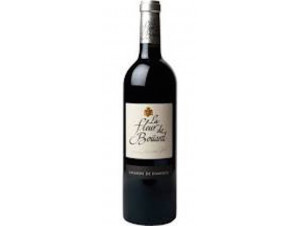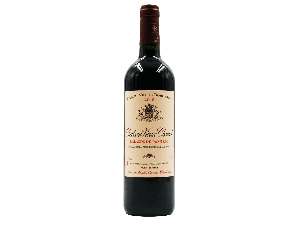You have no items in your shopping cart.
Wine Lalande-de-Pomerol
The AOC Lalande de Pomerol is located in the Libournais region, about 30 km east of Bordeaux. It is separated from Pomerol by the Barbanne river. It is located in two communes: Lalande de Pomerol and Néac. Close to the confluence of the Isle and Dordogne rivers, it is located less than 100 km west of the Atlantic Ocean. Read more on Lalande-de-Pomerol
-
Top Selling
-
Top Selling
-
Top Selling
Appellation Lalande-de-Pomerol
The vineyard of Lalande-de-Pomerol was conceived and designed by the Romans
As in Pomerol, the first vineyards of the appellation were created by the Romans, fine connoisseurs in terms of vines, who knew how to appreciate the potential of the region. In the 12th century and throughout the Middle Ages, they were cultivated by the commanderies of the Hospitallers of St John of Jerusalem (predecessors of the Knights of Malta). Pilgrims on their way to Santiago de Compostela stopped at Lalande de Pomerol and were accommodated there during their journey. During their journeys, they contributed to the excellent reputation of the wines of the Libourne region.
Destroyed during the Hundred Years' War, rebuilt several times during the 15th and 16th centuries, the vineyards of Lalande have continued to prosper since then. During the 19th century, the region's wine trade by sea was already thriving.
Alas, like the whole of the French vineyard, the territory of the appellation was hit by the phylloxera crisis at the end of the century. It was the daughter of a local winegrower, Caroline Ponsot, who contributed to the rescue of the infected vineyards by championing the use of American rootstock, which was immune to the disease. The AOC was validated by decree on 8 December 1936.
The wines of the Lalande-de-Pomerol appellation offer multiple personalities
Straddling two communes, Lalande de Pomerol and Néac, the appellation is situated on flat landscapes on the Pomerol side, while to the east, on the Néac side, the vineyards are planted on a high plateau, largely composed of alluvial terraces. The merlot is preponderant in the blending of these wines with a powerful character that are very similar to the wines of Pomerol.
Separated from Pomerol by the Barbanne stream, the Lalande de Pomerol terroir produces wines that are enjoyable young. However, like the terroirs of great variety, the wines of the appellation offer several faces: some emphasise fruitiness without really having keeping potential, others, more charpent, and quite similar to their Pomerol neighbours, are intended to be kept for longer.
The vineyard benefits from hot, dry summers and mild, wetter winters, an ideal combination, very conducive to grape growing. The terroir of Lalande de Pomerol has many variations, which are found in the wines of the appellation. By turns gravelly, clayey-gravelly, clayey, sandy-clayey, sandy-silty, it rests on a subsoil rich in iron oxides. Under the earth, ancient sea beds form a limestone plateau on which the roots of the vineyard rest.
Eroded and cut up over the last three million years by the rivers that still flow there today, the numerous sediments, stones and pebbles that have been carried there have contributed to the creation of the Bordeaux region. In particular, minerals from the Dordogne, the Massif Central and the Pyrenees have contributed to the great diversity of Bordeaux wines. Lalande de Pomerol thus extends its 1200 hectares of vines on alluvial terraces from the Tertiary era.
The wines of the appellation are composed of merlot, cabernet-franc and cabernet sauvignon. Merlot still remains dominant in the blends. No less than 54,000 hl/year of red wines are produced throughout the AOC.
Powerful and velvety tannins characterise the wines of Lalande-de-Pomerol
The wines of Lalande de Pomerol can be appreciated as much after a few years of ageing as in their prime youth. To the eye, the colour is dark, powerful, with a ruby and garnet hue. Their aromatic bouquet is very rich, the nose opens with notes of small red fruits, vanilla, toast, spices, candied fruits, prunes, violet, moss and truffle. And for the best of them, aromas of cocoa and game may tickle our nostrils.
On the palate, the tight tannins reveal themselves from the outset, only to melt away and offer the palate a deliciously velvety sensation.
They are equally at home in traditional French cuisine as in Asian or Mediterranean cuisine. They can be paired with the most refined dishes or simply associated with a grilled meat or pasta dish. But it is with red meats and game that they best express their power as well as the suave and nervous character of their combinations.
2009 is the vintage of the century for Lalande-de-Pomerol wines
The appellation's greatest vintages in recent years have been 2005 and 2009, considered vintages of the century. This had not happened since 1929. The last exceptional vintage was in 1995, and the last vintage of the millennium was 1990, which should be remembered.
The Lalande-de-Pomerol AOC benefits from a combination of state-of-the-art technology and tradition
Château Belles Graves
The estate's vineyards, formerly a place called Drouilleau, date back to the late Middle Ages, but it was in the 18th century that the château was erected. The estate's chartreuse offers a view of the vineyards of Pomerol and Saint-Emilion. Xavier Piton creates powerful and refined wines at Belles-Graves, made using traditional methods. All of the estate's wines are aged in French oak barrels.Château La Fleur de Boüard
It was Hubert de Boüard de Laforest, owner of Château Angélus, a major producer in Saint-Émilion, who decided to buy this vineyard in the Lalande de Pomerol appellation. Combining technology and traditional know-how, everything is done to produce exceptional crus. The estate is located partly on the Néac plateau, thus benefiting from its clay gravel. Its Le Plus de la Fleur de Boüard cuvée has the undisguised aim of competing with the great vintages of Pomerol.Château des Arnauds
The vineyard of Château des Arnauds covers 14.5 hectares, straddling two appellation areas of Lalande de Pomerol and Bordeaux. Château des Arnauds has been passed down from father to son since 1914, when Jacques Arnauds acquired the plots of land that make up the famous wines of the appellation. The vineyard is 85% merlot and 15% cabernet franc. It is the Merlot, characteristic of Libourne wines, that will give the wine its finesse. The Cabernet Franc gives it its structure and powerful aromatic bouquet.
Bordeaux appellations




































 TWIL - Achat de Vin
TWIL - Achat de Vin


